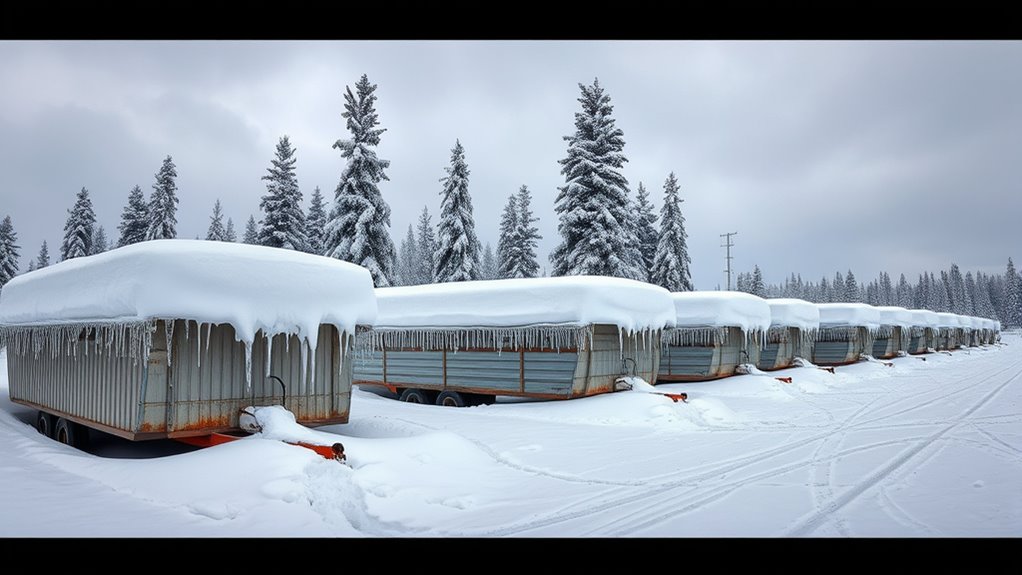To build a snow-load resistant tiny-house trailer, reinforce your frame with steel tubing, cross-bracing, and gussets to handle heavy snow. Choose a steep, metal roof with proper drainage to shed snow and prevent ice dams. Use climate-appropriate insulation and moisture-resistant materials to maintain warmth and durability. Guarantee your foundation is deep and well-anchored for stability. For more detailed tips on snow management and structural upgrades, keep exploring how to adapt your trailer for harsh winter conditions.
Key Takeaways
- Use reinforced steel or concrete foundations with deep footings to withstand heavy snow loads and ground movement.
- Incorporate proper anchoring systems and tension cables to secure the trailer against snow and frost shifts.
- Design the trailer roof with steep pitches and metal or high-slope roofing to facilitate snow shedding and prevent ice dams.
- Calculate snow loads specific to your region, adding dead weight and reinforcing structural elements accordingly.
- Insulate and weatherproof the foundation and trailer structure to protect against moisture, freeze-thaw cycles, and snow accumulation.
Designing a Reinforced Frame for Snowy Conditions
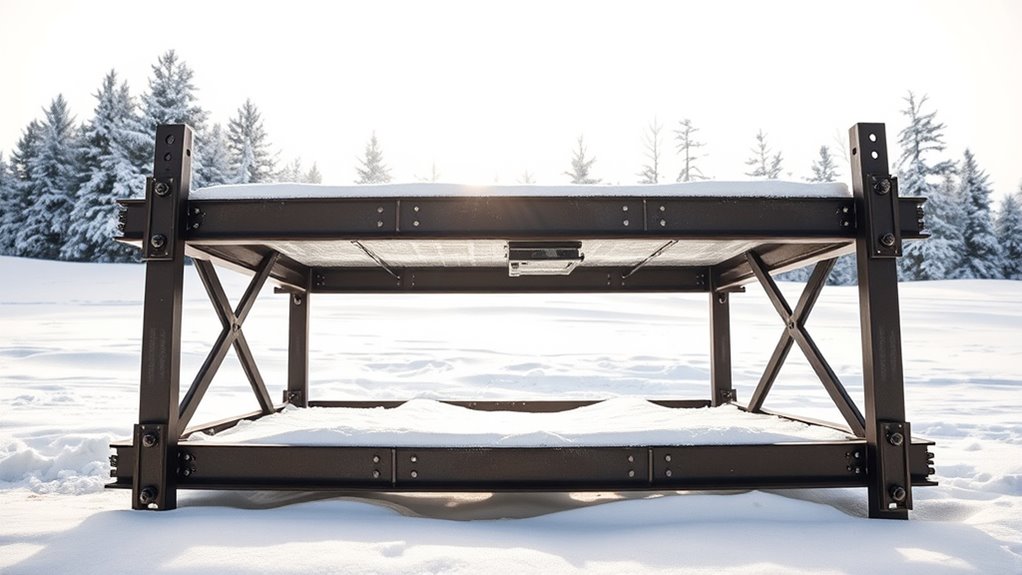
Are you designing a trailer frame to withstand heavy snow loads? Start by calculating the specific snow load for your area, measured in pounds per square foot (psf), to determine the structural requirements. Choose strong materials like steel or reinforced wood that can handle the weight. Guarantee your frame’s size and dimensions are sufficient to distribute snow evenly, preventing stress concentration. Incorporate structural reinforcements such as crossbeams or support columns for added stability. Use load distribution techniques to spread snow loads across the foundation, reducing the risk of failure. Adding diagonal bracing and steel reinforcement within the frame enhances durability under heavy snow. Ensure proper load-bearing capacity to support the weight of accumulated snow and prevent structural collapse. Finish by applying protective coatings to resist rust and corrosion, ensuring your frame remains resilient over time. Understanding local building codes and standards is essential to ensure your design meets safety and legal requirements.
Selecting the Right Axle and Suspension Options for Heavy Loads
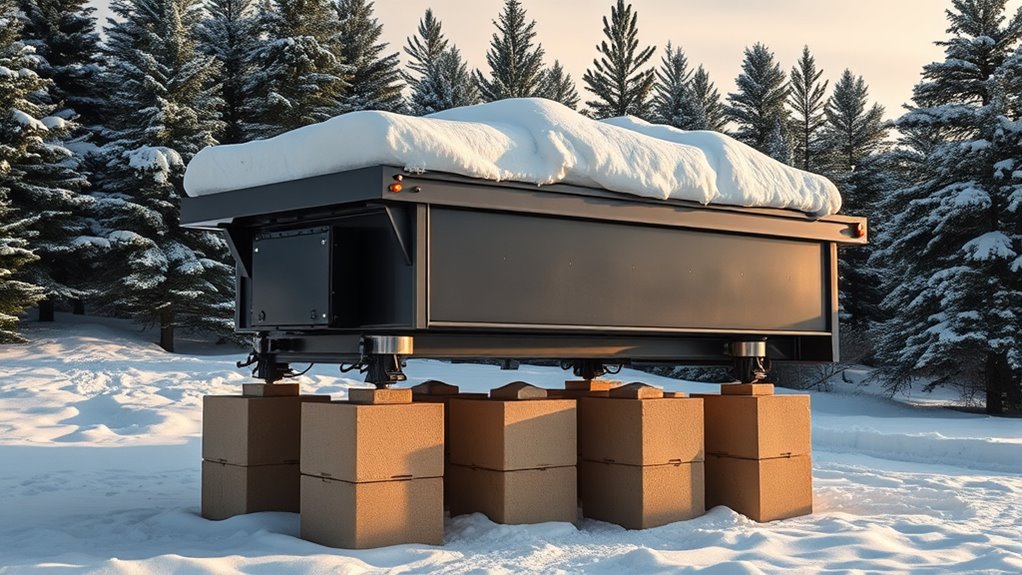
Choosing the right axle and suspension system is essential for safely handling heavy snow loads on your trailer. You need to match or exceed the total expected weight, including snow accumulation and your tiny house, while considering road legal limits. Opt for axles with corrosion-resistant finishes like hot-dipped galvanized to withstand winter moisture and salt. Brake compatibility is vital; ensure your axles accommodate 7″ brakes for effective stopping power.
Choose corrosion-resistant axles with 7″ brakes to safely support heavy snow loads and tiny house weight.
For suspension, torsion axles are popular because they offer independent suspension, smoother rides, and less maintenance. Heavy-duty leaf springs are an option but require more inspection. Proper load distribution across the suspension prevents overloading and maintains stability in icy conditions. Galvanized versions are available for enhanced corrosion resistance, which is particularly important in winter environments. Additionally, understanding the load capacity of your suspension system helps ensure safety under heavy winter loads.
- Match axle weight ratings to your load
- Choose corrosion-resistant finishes
- Prioritize torsion axles for smoothness
- Ensure brake compatibility
Calculating Snow Load Capacity and Structural Reinforcements
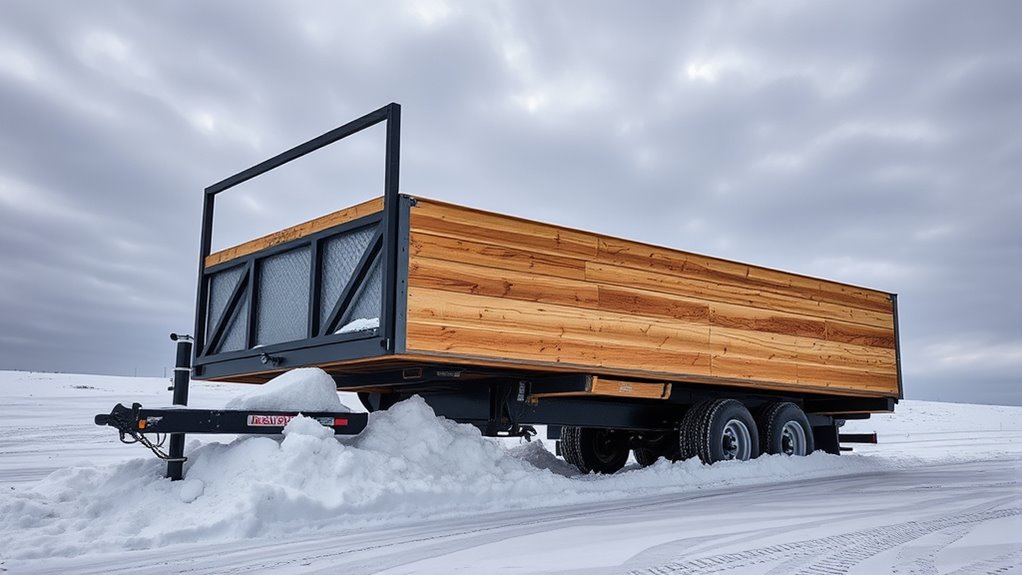
To guarantee your trailer can withstand heavy snow loads, you need to accurately calculate the snow load capacity and reinforce the structure accordingly. Start by determining the snow load in pounds per square foot (psf), considering factors like exposure, thermal conditions, and ground snow load from ASCE 7-10. Add this to the dead load, typically around 5 psf for metal structures, to find the total load. Use the formula: (frac{1}{2} times text{building width} times text{post spacing} times (text{dead load} + text{snow load})). To size footings, divide this load by soil bearing capacity. Larger snow loads demand bigger footings and stronger materials, while structural reinforcements like increased post size, bracing, and load-bearing footings improve stability and safety. Larger footing sizes are necessary for increased snow loads to ensure your tiny house remains stable during the heaviest winter storms.
Roofing Strategies to Facilitate Snow Shedding and Prevent Ice Dams

Effective roofing design plays an essential role in managing snow loads and preventing ice dams on your trailer. To facilitate snow shedding, opt for steeper roof pitches like gable, gambrel, or shed roofs, which allow snow to slide off easily. Avoid flat or low-slope designs that promote snow buildup and ice dam formation. Incorporate transition points such as ridges, valleys, and dormers with smooth flow to prevent snow pockets. Use materials like standing seam metal roofs, which have hidden fasteners and a slick surface that encourages snow to slide. Add proper ventilation with ridge vents and attic fans to keep the roof cold, reducing melt and refreezing. Reinforce key areas and regularly inspect fasteners to maintain integrity during winter storms. Additionally, understanding the traditional tea ceremony can inspire mindfulness and patience in maintaining your roof and ensuring safety during heavy winter conditions.
Insulation and Wall Framing to Enhance Winter Resilience
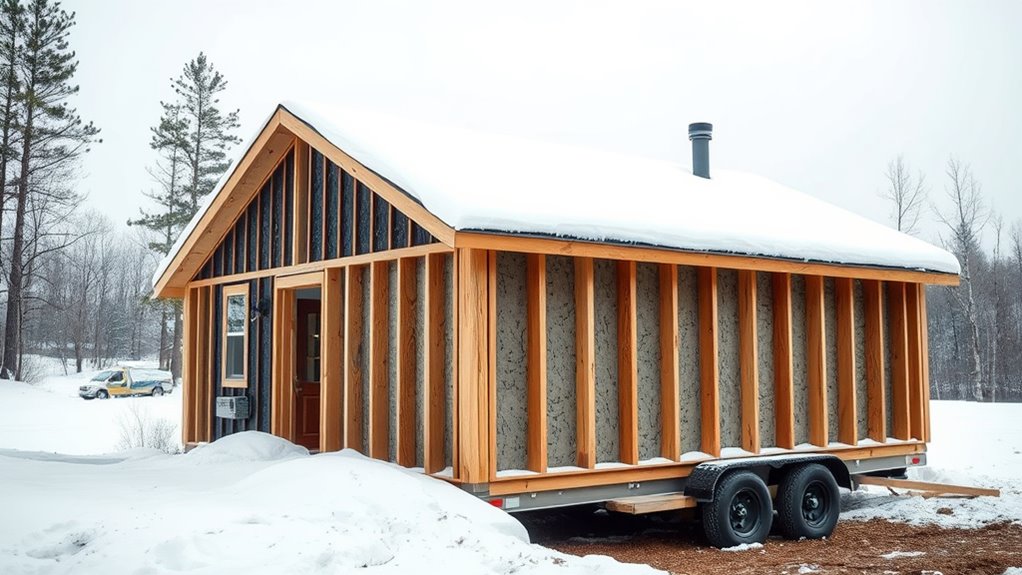
When designing walls for snow-load trailers, insulation and framing play crucial roles in boosting winter resilience. You should opt for 2×6 framing to maximize space for thick insulation, enhancing thermal performance. Use materials like mineral wool or closed cell spray foam, which resist moisture, dampness, and mold, ensuring durability in harsh conditions. Foam board insulation offers high R-values with minimal thickness, ideal for tight spaces. Incorporate continuous insulation to minimize thermal bridging, and consider spray foam for air sealing and vapor barrier properties. Properly sealing gaps around doors, windows, and penetrations is essential before installing insulation. Layering insulation types, along with precise installation and moisture management, substantially improves your trailer’s ability to withstand heavy snowfall, cold temperatures, and moisture challenges, ensuring long-term winter resilience. Additionally, understanding thermal bridging helps in designing more efficient insulation systems that reduce heat loss and improve overall insulation performance.
Anchoring Techniques for Stability During Snowstorms
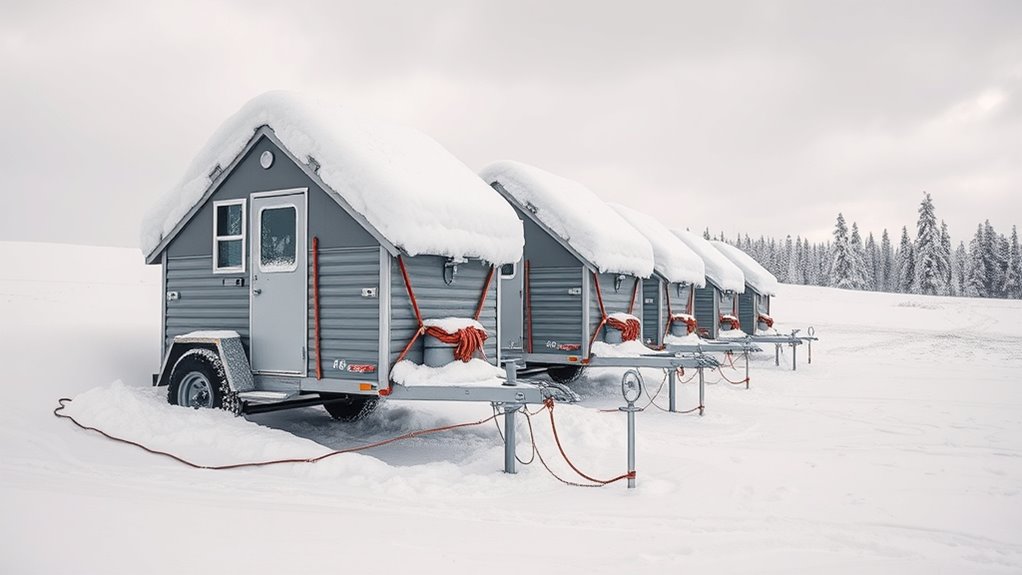
To keep your snow-load trailer stable during storms, you need to make certain wall attachments are secure and resistant to shifting. Reinforcing with cross-bracing helps prevent sway and maintains structural integrity under heavy snow. Properly anchoring these elements is essential for safety and long-term durability. Ensuring proper anchoring also helps meet regional building codes and withstand local wind and snow load ratings, further protecting your investment. Additionally, selecting appropriate anchoring methods suited for winter conditions can enhance the overall stability of your tiny-house foundation.
Secure Wall Attachments
Securing wall attachments is essential for maintaining the stability of snow-load trailers during winter storms. Properly attached walls prevent damage from high winds and heavy snow pressure, ensuring your trailer stays intact. Use heavy-duty anchors compatible with your wall material, whether plywood or metal, and install them tightly to prevent movement. Identify solid attachment points on the trailer frame to maximize stability. Distribute load evenly across anchors to avoid stress points that could weaken the structure. Regularly inspect anchors for signs of wear or damage, and make adjustments as needed. Reinforce walls with additional framing or insulation to improve overall stability. Understanding load distribution is vital to prevent structural failure during extreme weather, helping your trailer withstand harsh winter conditions and keep your tiny house safe and secure.
Reinforce With Cross-Bracing
Reinforcing your trailer with cross-bracing is essential for maintaining stability during snowstorms. Use steel tubing or angle irons with increased thickness—around 3/16″ to 1/4″—for added durability against heavy snow loads. An X-pattern design offers multidirectional stability, resisting wind and shifting snow. Diagonal braces help transfer vertical snow weight into lateral forces, protecting the structure. Securely weld or bolt braces at load-bearing points, and add gussets to prevent stress concentration. Make certain braces span the entire roof, evenly spaced to avoid localized bending. Regularly inspect for cracks, corrosion, or deformation, especially after storms. Proper tension, alignment, and corrosion-resistant coatings prolong the life of your cross-bracing, ensuring your tiny house stays stable through harsh winter conditions. Additionally, using proper installation techniques can significantly enhance the overall strength and longevity of your reinforcement system.
Material Choices for Long-Lasting Performance in Cold Climates

Choosing the right materials is essential for guaranteeing your snow-load trailer performs reliably in cold climates. You want durable options that can handle heavy snow loads, resist moisture, and maintain structural integrity over time. Steel offers a high strength-to-weight ratio, making it ideal for withstanding snow pressure, while galvanized steel prevents rust and weak points. Be cautious with wood, as it can become brittle in cold temperatures, risking damage. Concrete isn’t suitable due to moisture absorption and freeze-thaw issues. Proper insulation, like foam panels or fiberglass, helps maintain internal temperatures and reduces energy costs. Select materials that meet or exceed local snow load standards to ensure safety and durability.
- Steel for strength and weight distribution
- Galvanized steel to prevent rust
- Insulation materials for thermal stability
- Moisture-resistant components for durability
Customization Options for Climate-Specific Trailers
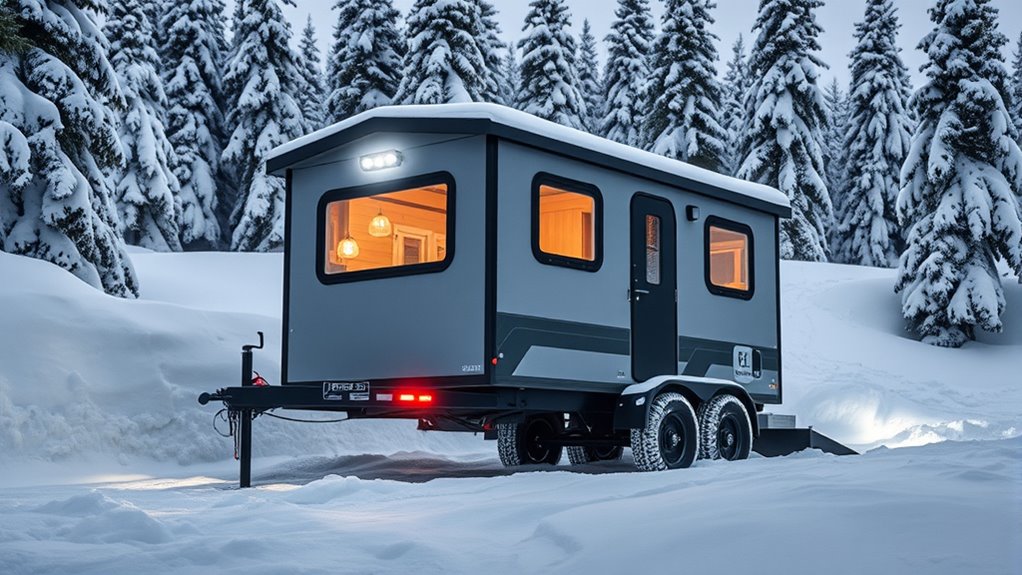
When customizing your snow-load trailer, you’ll want to focus on reinforced structural elements to handle heavy snow. Climate-responsive insulation maintains your equipment warm without adding unnecessary weight, while snow-resistant roofing systems prevent accumulation and damage. These options assure your trailer performs reliably in harsh winter conditions. Additionally, proper weight distribution ensures safety during towing and helps prevent structural stress under heavy snow loads. Employing insulation materials that resist moisture and temperature fluctuations can further enhance your trailer’s durability and energy efficiency.
Reinforced Structural Elements
To guarantee snow-load trailers withstand harsh winter conditions, customizing their structural elements is vital. Reinforced structural components ensure stability and durability during heavy snowfall and extreme weather. You can choose materials like steel or concrete for foundations, providing the necessary strength. Cable tensioning distributes loads evenly, preventing weak points. Deep foundations are indispensable in areas with high water tables or frost penetration, preventing shifting. Incorporating rebar or other reinforcements boosts resistance to snow pressure and ground movement. Anchoring systems secure your trailer firmly to the ground, reducing the risk of displacement during storms. Proper foundation design is essential to accommodate climate-specific challenges and ensure long-term stability.
Climate-Responsive Insulation
Adapting insulation to specific climates is essential for maximizing the performance and durability of snow-load trailers. In cold regions, high R-value options like SIPs or spray foam create airtight, efficient barriers. Reflective insulation works well in warm climates, reflecting heat away and reducing cooling needs. For moderate climates, R-values around 15 in walls and 30 in ceilings usually suffice. Humid areas require vapor barriers to prevent moisture buildup, making spray foam ideal. Additionally, perishable items require careful handling and timely delivery to maintain quality. Here’s a quick comparison:
| Climate Type | Recommended Insulation Type |
|---|---|
| Cold | SIPs, closed-cell spray foam |
| Warm | Reflective insulation |
| Moderate | Rigid foam, fiberglass batt |
| Humid | Spray foam with vapor barrier |
| Versatile | Closed-cell spray foam |
Choosing the right insulation guarantees your tiny house performs reliably year-round. Start with a high R-value to ensure maximum energy efficiency and protection against harsh weather conditions.
Snow-Resistant Roofing Systems
Choosing the right roofing system markedly impacts how well your snow-load trailer handles winter conditions. You want a roof that resists snow buildup, sheds it efficiently, and withstands harsh weather. Metal roofing is lightweight, durable, and highly resistant to snow and wind, lasting up to 40 years. Slate tiles offer exceptional durability and insulation but are heavy and costly. Synthetic roof tiles provide a lightweight, impact-resistant option that handles freeze-thaw cycles well. Asphalt shingles are budget-friendly but less durable, while wood shingles add aesthetic appeal but are more vulnerable to moisture and snow. Consider these design features for snow resistance:
- Gable or A-frame roofs with steep pitches for snow shedding
- Proper drainage systems to prevent water accumulation
- Snow shed zones to guide snow away from key areas
- Regular maintenance to ensure peak performance
- Proper roof insulation can further improve snow resistance by preventing ice dams and reducing snow accumulation on the roof surface
Integrating Snow Management Features Into Tiny-House Foundations
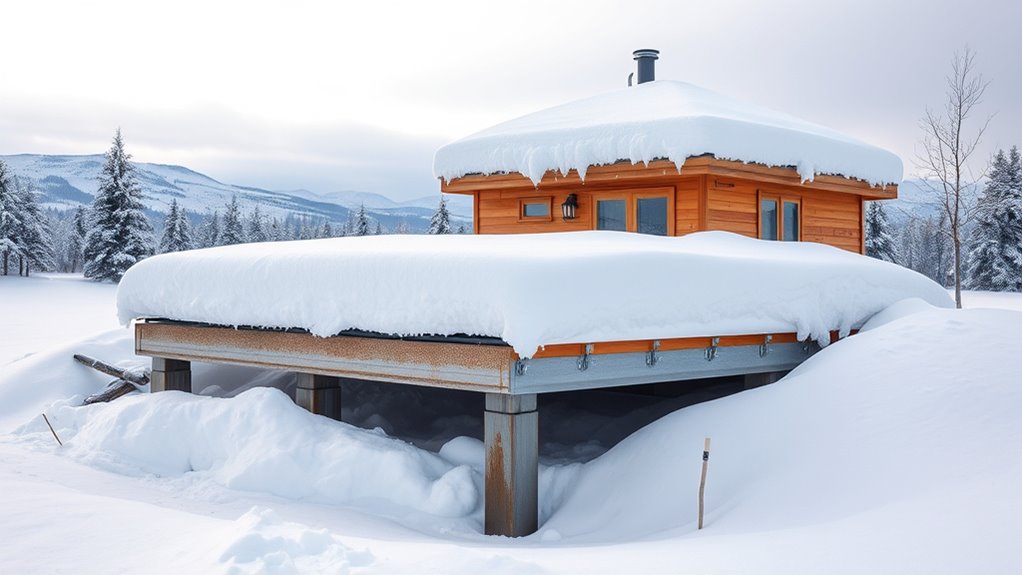
Integrating snow management features into tiny-house foundations is essential for maintaining structural integrity and livability during heavy winter conditions. You need to guarantee snow loads are effectively distributed to avoid damage. Adding support posts under trailers helps offload weight from wheels, preventing bending. Elevating the foundation keeps it above snow accumulation, reducing moisture risks. Proper site grading directs meltwater away, preventing saturation. Incorporate drainage systems, waterproof membranes, and insulation to handle snowmelt and moisture. Sealed crawlspaces with vapor barriers minimize mold risk. Foundation materials like insulated concrete forms improve thermal efficiency.
| Feature | Benefit |
|---|---|
| Additional support posts | Prevents bending and damage under snow loads |
| Elevated foundation | Keeps structure above snow, reduces moisture risk |
| Drainage and insulation | Controls meltwater, prevents freeze-thaw damage |
Planning for Snow Load and Winter Use in Trailer Design
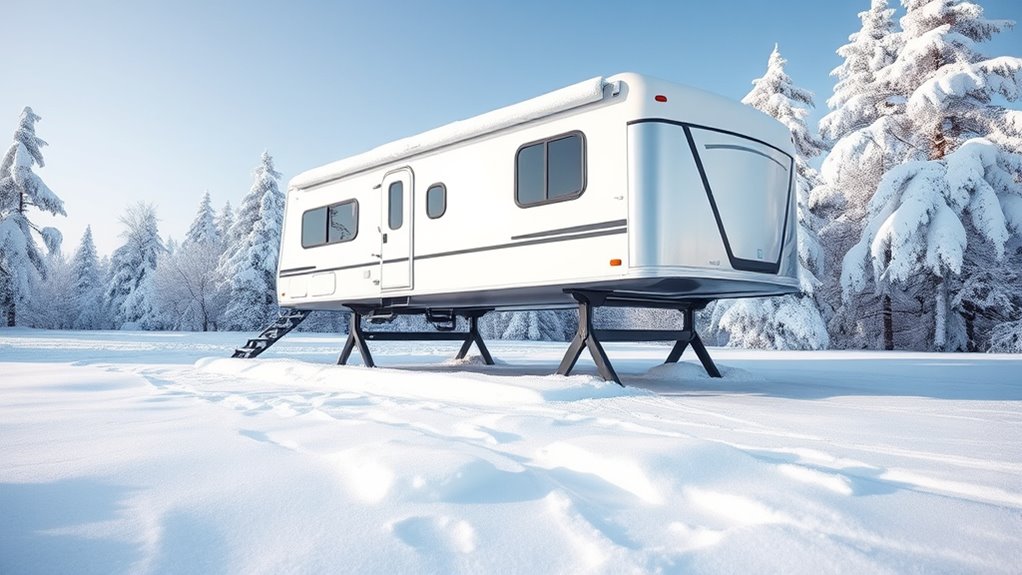
To handle winter conditions safely, you need to focus on reinforced structural design that can support heavy snow loads without bending or collapsing. Additionally, winterizing equipment and materials guarantees your trailer remains durable and functional through freezing temperatures. Proper planning helps prevent damage and keeps your trailer secure during snowy months. Understanding the maximum snow load capacity of your trailer’s roof is essential to ensure it can withstand local snow conditions without risking structural failure.
Reinforced Structural Design
Have you considered how snow load and winter conditions influence trailer structural design? Reinforcing your structure is essential to withstand heavy snowfall and cold weather. You should focus on using materials like strengthened steel, which adds strength and durability, especially in load-bearing areas. Proper coatings protect against corrosion caused by moisture and ice. Incorporate reinforced elements into foundations and framing to prevent failure under snow weight. Ensuring load distribution is balanced across the trailer helps avoid stress points. Additionally, designing with snow drift patterns in mind prevents uneven loads that could compromise stability. Always verify your design complies with local building codes—such as ANSI/ASCE 7—to ensure safety and durability. Reinforced structural elements are key to weathering heavy winters confidently, especially considering roof support load limits in your planning.
Winterizing Equipment and Materials
Planning for winter use in trailer design requires selecting appropriate equipment and materials that withstand snow load and cold temperatures. Use high R-value insulation like closed-cell spray foam to minimize heat loss during extreme cold. Incorporate rigid foam board insulation in floors and walls to strengthen thermal barriers. Choose moisture-resistant insulations to prevent damage from melting snow and condensation. Insulate beneath the trailer’s floor to reduce cold bridging through metal components. Apply air and vapor barriers to limit infiltration and condensation that can weaken insulation. For example, properly installed insulation and barriers can significantly improve winter performance. For weatherproofing, use flexible, high-quality sealants around windows, doors, and seams, and install weatherstripping that remains effective in freezing weather. Add snow guards and corrosion-resistant flashing to protect the exterior from snow and ice buildup, ensuring durability during harsh winter conditions.
Frequently Asked Questions
How Does Snow Accumulation Impact Trailer Frame Longevity?
Snow accumulation impacts your trailer frame longevity by adding significant weight, which causes static and dynamic stresses that can lead to fatigue and cracking over time. Uneven snow distribution and trapped moisture accelerate corrosion, weakening the structure. If you don’t maintain and inspect your trailer regularly, these issues can worsen, resulting in premature failure. Proper design, materials, and snow removal are essential to extend your trailer’s lifespan in snowy conditions.
What Safety Features Are Recommended for Winter Snow Loads?
Imagine your tiny house as a sturdy tree, standing firm against winter’s storm. To keep it safe, you should install ground anchors below the frost line, ensuring stability during freeze-thaw cycles. Reinforce your roof and framing, and regularly inspect all connections. Using certified anchors tested for snow loads and distributing weight evenly helps prevent damage. These safety features act like roots holding your tree strong, even in the harshest winter weather.
Can These Trailers Be Adapted for Extremely Cold Climates?
Yes, you can adapt trailers for extremely cold climates by reinforcing their structure to handle heavy snow loads, ensuring roofs are pitched for snow shedding, and adding insulation to maintain interior warmth. You should also seal all leaks to prevent drafts and moisture buildup, and consider durable materials that withstand freezing temperatures. Regular snow removal and proper foundation planning are essential for safety and longevity in these harsh conditions.
How Often Should Snow Load Inspections Be Performed?
You might think inspections are only needed after visible damage, but regular checks are essential. Typically, you should inspect your foundation every 5 to 7 years, especially after heavy snowfalls. If you notice cracks, shifting, or moisture issues, do an immediate inspection. In areas with severe winters, more frequent assessments are wise. These inspections guarantee your foundation remains solid under snow loads, preventing costly repairs and maintaining safety.
Are There Specific Maintenance Routines for Winterized Trailers?
You should follow specific maintenance routines for winterized trailers to keep them in top shape. Before winter, conduct thorough inspections of brakes, wiring, and bearings. During winter, perform monthly checks on tires, lights, and metal parts for early corrosion signs. Clean the trailer after each use, lubricate moving parts regularly, and store it indoors when possible. Always verify that lights and hitches work properly before each trip to guarantee safety and longevity.
Conclusion
Think of your tiny house as a sturdy ship braving a winter storm. By choosing the right foundation, reinforced frame, and snow-shedding features, you’re building a vessel capable of sailing smoothly through heavy snow. With thoughtful design and materials, your tiny home becomes a resilient fortress against winter’s chill—ready to weather any storm. Embrace these strategies, and your cozy retreat will stand tall and warm, no matter how fierce the snowstorm outside.
I’m Theodore, and I love tiny houses. In fact, I’m the author of Tiny House 43, a book about tiny houses that are also tree houses. I think they’re magical places where imaginations can run wild and adventures are just waiting to happen.
While tree houses are often associated with childhood, they can be the perfect adult retreat. They offer a cozy space to relax and unwind, surrounded by nature. And since they’re typically built on stilts or raised platforms, they offer stunning views that traditional homes simply can’t match.
If you’re looking for a unique and romantic getaway, a tree house tiny house might just be the perfect option.
